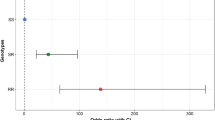Abstract
Alpha-(1,2)-fucosyltransferase (FUT1) gene has been identified as a candidate gene for regulating the expression of Escherichia coli F18 receptor gene (ECF18R) which promotes adherence of Enterotoxigenic (ETEC) and Verotoxigenic (VTEC) Escherichia coli (E. coli) via F18 fimbriae. In order to illustrate the polymorphisms of FUT1 and their effects on resistance to natural infection by Porcine Respiratory and Reproductive Symdrome Virus (PRRSV) and Haemophilus parasuis, the distributions of different genotypes and the relative risks of disease incidence in pigs were investigated. A total of 1,041 pigs representing three European breeds (Duroc, Landrace and LargeWhite), five Chinese local breeds (Wild pig, Small MeiShan, QinPing, JinHua, and JianLi) and three commercial populations (LargeWhite × JianLi, Duroc × Landrace × LargeWhite and Duroc × wild pig) were selected to analyze the genotype of the FUT1 gene by PCR-RFLP. Only the GG genotype associated with susceptibility to ECF18 bacteria was detected in Chinese local pig breeds and a population of LargeWhite × JianLi, while the AA genotype which confers resistance to ECF18 was detected in two European breeds (Duroc and LargeWhite), two populations of Duroc × wild pig and Duroc × Landrace × LargeWhite. Regarding relative risk of incidence, Duroc × Landrace × LargeWhite with genotypes GG or AG showed greater relative risk (OR = 2.040, P = 0.025; OR = 1.750, P = 0.081, respectively) than those with genotype AA during natural infection by both PRRSV and Haemophilus parasuis. It can be concluded that the mutation of FUT1 gene might play a role in pig infection by multi-pathogens, and that AA may be a favourable genotype for increasing the resistance to disease.

Similar content being viewed by others
References
Nguyen Ngoc H, Tasca C, Watrin C, Milon A (2002) Adhesion of Escherichia coli isolates from edema disease to HeLa, LLCPK-1 cells and swine intestinal villi. Rev Med Vet 153:795–800
Imberechts H, De Greve H, Schlicker C, Bouchet H, Pohl P, Charlier G, Bertschinger H, Wild P, Vandekerckhove J, van Damme J (1992) Characterization of F107 fimbriae of Escherichia coli 107/86 which causes edema disease in pigs and nucleotide sequence of F107 major fimbrial subunit gene, fedA. Infect Immun 60:1963–1971
Bertschinger HU (1999) Postweaning Escherichia coli diarrhea and edema disease. In: Straw BE, D’Allaire S, Mengeling WL, Taylor DJ (eds) Diseases of swine. Iowa State University Press, Ames, IA, pp 441–454
Coddens A, Verdonck F, Tiels P, Rasschaert K, Goddeeris BM, Cox E (2007) The age-dependent expression of the F18+ E. coli receptor on porcine gut epithelial cells is positively correlated with the presence of histo-blood group antigens. Vet Microbiol 122:332–341
Vögeli P, Bertschinger HU, Stamm M, Stricker C, Hagger C, Fries R, Rapacz J, Stranzinger G (1996) Genes specifying receptors for F18 fimbriated Escherichia coli, causing oedema disease and postweaning diarrhoea in pigs, map to chromosome 6. Anim Genet 27:321–328
Meijerink E, Fries R, Vogeli P, Masabanda J, Wigger G, Stricker C, Neuenschwander S, Bertschinger HU, Stranzinger G (1997) Two α(1, 2) fucosyltransferase genes on porcine chromosome 6q11 are closely linked to the blood group inhibitor (S) and Escherichia coli F18 receptor (ECF18R) loci. Mamm Genome 8:736–741
Watkins WM (1980) Biochemistry and genetics of the ABO, Lewis, and P blood group systems. Adv Hum Genet 10(1–136):379–385
Vögeli P, Meijerink E, Fries R, Stricker C, Bertschinger HU (1997) A molecular test for the detection of E. coli F18 receptors: a breakthrough in the struggle against edema and post-weaning diarrhoea in swine. Schweiz.Arch. Tierheilk 139:479–484
Klukowska J, Urbaniak B, Switonski M (1999) High frequency of M307A mutation at FUT1 locus, causing resistance to edema disease, in an autochthonous polish pig breed, the Zlotnicka spotted. J Anim Breed Genet 116:519–524
Shi QS, Huang SQ, Liu XC, He CQ, Jiang J (2003) Polymorphism of E. coli F18 receptor gene in different pig breeds. Acta Genetica Sinica 30:221–224
Yan XM, Guo YM, Ding NS, Ren J, Huang LS (2004) Study on the genetic variation of α1-fucosytransferase gene in different pig breed. Chin J Anim Sci 40:8–10
Bao WB, Wu SL, Musa HH, Zhu GQ, Chen GH (2008) Genetic variation at the alpha-1-fucosyltransferase (FUT1) gene in Asian wild pig and Chinese and Western commercial pig breeds. J Anim Breed Genet 125:427–430
Sambrook J, Fritsch EF, Maniatis T (1989) Molecular cloning: a laboratory manual, 2nd edn. Cold Spring Harbor Laboratory Press, New York
Sole X, Guino E, Valls J, Iniesta R, Moreno V (2006) SNPStats: a web tool for the analysis of association studies. Bioinformatics 22:1928–1929
Ciobanu DC, Dayc AE, Nagy AN, Rothschild MF, Plastow GS (2001) Genetic variation in two conserved local Romanian pig breeds using type 1 DNA markers. Genet Sel Evol 33:417–432
He WM, Jiang YF, Luo WH, Huang JW, Zhang YJ, Li MQ, Liu BZ (2001) Pathogenic diagnosis and epidemiological investigation on edema disease of pigs. Acta Agric Boreali-occidentalis Sinica 10:1–5
Leng CY, Su DH (2006) Prevention and cure of edema disease in piglets. J. Anim Sci Vet Med 25:67–68
Nystrom K, Grahn A, Lindh M, Brytting M, Mandel U, Larson G, Olofsson S (2007) Virus-induced transcriptional activation of host FUT genes associated with neo-expression of Ley in cytomegalovirus-infected and sialyl-Lex in varicella-zoster virus-infected diploid human cells. Glycobiology 17:355–366
Marionneau S, Cailleau-Thomas A, Rocher J, Le Moullac-Vaidye B, Ruvoe¨n-Clouet N, Clément M, Le Pendu J (2001) ABH and Lewis histo-blood group antigens, a model for the meaning of oligosaccharide diversity in the face of a changing world. Biochimie 83:565–573
Acknowledgments
We thank farm staffs who help to collect all the related data. Financial assistance from Chinese government (2009ZX08009-142B, 2008ZX08007-003, S2010GR0947, 2010-Z16), Wuhan international project (201070934339), Grant of Innovation China UK Proof of Concept project (ICUK PoC-RVC-003) are greatly appreciated.
Author information
Authors and Affiliations
Corresponding author
Additional information
S. J. Wang and W. J. Liu contributed equally to this work.
Rights and permissions
About this article
Cite this article
Wang, S.J., Liu, W.J., Yang, L.G. et al. Effects of FUT1 gene mutation on resistance to infectious disease. Mol Biol Rep 39, 2805–2810 (2012). https://doi.org/10.1007/s11033-011-1039-0
Received:
Accepted:
Published:
Issue Date:
DOI: https://doi.org/10.1007/s11033-011-1039-0



